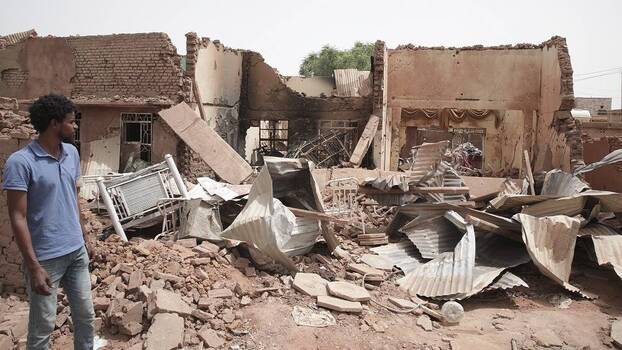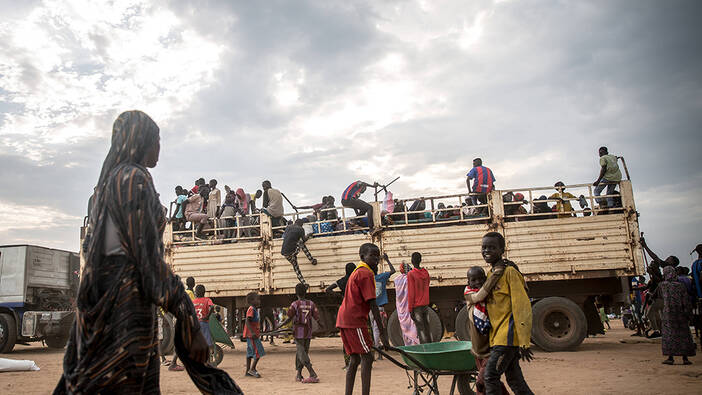
The war that broke out in the Sudanese capital Khartoum on 15 April 2023 brought an abrupt end to the over 15 months of continuous protests against the military coup, paralysed a thriving resistance movement, and, above all, inflicted suffering on millions of people living in Sudan.
Muzan Alneel is a Sudanese writer and public speaker with an interdisciplinary background in engineering, socioeconomics, and public policy.
The resistance front — a broad coalition of popular groups that participated in the revolution in 2019 and have kept up their activity since — underwent severe changes during this year. Pre-existing dynamics and ideologies intensified by the war drove the narratives of peaceful revolutionary resistance to retreat from the public sphere, where the narratives of war and violence now dominate.
The current reality of Sudan is one in which the people suffer under the armies’ war, while the resistance is losing the battle for influence in society and the war of position against the ruling class. If it does not change course soon, Sudan may be well on the way back to dictatorship.
From a Military Coup to Open Warfare
In the months leading up to April 2023, the Sudanese organized resistance front underwent an accelerated evolution in the development of the neighbourhood resistance committees (RCs). These grassroots organizations started forming in early 2019 following a call by the Sudanese Professional Association — the body leading the protests against the regime at the time — to form neighbourhood-level resistance organizations to implement a tactic of simultaneous decentralized protests. Since the beginning of the revolution in December 2019, these RCs, along with similar committees formed at the workplace level and issue-based groups, have been committed to advancing the goals of the revolution — freedom, peace, and justice — and thereby formed Sudan’s organized resistance front.
Following the formation of the transitional coalition government between the military council of the old regime and the Forces of Freedom and Change (FFC), the RCs spent months testing and defining their position in the new political setup. The FFC was a coalition of the traditional opposition parties, mostly representative of the agricultural and commercial capital, as well as urban reformist parties. While the FFC’s bourgeois interests led it into a partnership with the old regime in exchange for a seat at the table, it still had to win over the revolutionary RCs, insisting that a compromise with the military council was the only “realistic path” to achieving the revolution’s goals.
For years, the RCs tread a fine line of supporting the coalition government — official propaganda portrayed the two sides as being in harmony and vilified all criticism of the transitional government as sabotage by the ousted regime— while pushing to advance the agenda of the revolution, particularly with regard to criminal and economic justice. Yet the regime’s glowing propaganda was contradicted by reality, as every action, decision, and position taken by the new regime prioritized preserving the partnership and shielding the old economic and political elites over advancing the goals of the revolution, proving that the two goals were irreconcilable.
While organizing continuous protests that paralyzed the coup government, the RCs also organized a deliberation process encompassing some 8,000 neighbourhood resistance committees around the country.
As the positions and policies of the FFC and the civilian half of the government ate away at their popular support, the military council saw an opportunity to take more power and executed a coup via the two major components of the military council, the Sudanese Armed Forces (SAF) and the Rapid Support Forces (RSF). However, the military and its para-military “child” (a popular term used to describe the RSF) failed to take the organized resistance into account. Due to their efforts, popular opposition to the coalition government did not feed support for the coup, but on the contrary ignited resistance to the entire existing ruling class, rejection of the military coup, and a call for a fully civilian government created from the bottom up.
While organizing continuous protests that paralyzed the coup government, the RCs also organized a deliberation process encompassing some 8,000 neighbourhood resistance committees around the country that resulted in a series of political charters and road maps. The ruling class worked desperately to stifle the resistance movement, while international and regional media continued to ignore it, and instead gave space to the different fractions of the ruling class and their bickering. International organizations such as the UN called on the Sudanese resistance to be realistic and accept another partnership with the military. The UN mission in the country urged the RCs to participate in negotiations with the military, which the UN pushed for against the will of the people.
The success of the resistance front in advancing its position was captured in the slogan of the “Three Nos” — no negotiations, no partnership, no legitimization — against the military council. The slogan was chanted in protests and even the parties of the FFC felt compelled to include it at the bottom of their statements. The RCs took the position that the current coup was the result of previous instances in which illegal seizures of power were retroactively legitimized, and argued that legitimization of the latest coup would only encourage further violence and perhaps even a war. Yet international political and media organizations ignored this argument, and a war soon followed.
Growing Contradictions
For the two warring entities — both of which had expanded their influence using violence, massacres, and coups, and faced no consequences other than further legitimization — it was only logical to attempt a full takeover via further violence. Thus, war broke out between the RSF and the SAF, thereby — as was also the case in previous wars — intensifying the suffering of the Sudanese people, the armed forces’ totalitarian grip over civilian life, and their extraction of Sudanese wealth for their own benefit.
The war also brought back to the surface the reactionary ideologies that the resistance had been making inroads against. Chants of “Free health care and education, and the military back to its barracks!” were gradually replaced by patriotic support for the army in the face of the “militia rebellion”.
The RCs attempted to strike an impossible balance between calling for an end to the war and supporting the army of the coup government. This was the result of a lack of clear analysis of the state as a tool of the ruling class. These analytical weaknesses could be seen in positions taken up by segments of the resistance in previous years, such as legitimizing the SAF over the RSF based on bureaucratic distinctions (in terms of the SAF’s position in the state apparatus), rather than opposing both given their role in impoverishing and oppressing the people.
In the meantime, the majority of the parties that previously formed the FFC created a new coalition that appeared to align with the RSF, a renewed attempt at partnering with criminals in exchange for a seat at the table, which they mostly justified by citing the ousted regime’s control of the SAF. Nevertheless, that sort of internal bickering among the ruling class is outside the scope of this analysis.
The resistance’s wartime support for an imagined “good national army” is based on the SAF’s alleged institutional nature as opposed to the RSF — as if said institutionality was ever reflected in accountability for the SAF, or, for that matter, its offspring militia while it was under its control. The resistance also cites external support for the RSF (specifically, from the United Arab Emirates) as evidence of their treasonous nature, as if the hunger and death inflicted on Sudan’s people is different when inflicted by those from within its borders.
Even the end of the war — whether in one year or in 20 — could usher in the worst possible outcome: a totalitarian regime with mass support.
For months, the RCs attempted to hold together two contradicting goals: namely, the revolution’s goal of protecting and prioritizing human life, and the counter-revolution’s goal of protecting the state. The counter-revolution, boosted by decades of bourgeois propaganda promoting patriotism over human life, appears to have defeated the revolution, and while the RCs post about the death and devastation caused by the actions of both the RSF and the SAF on social media, posts about the former are filled with comments of support, while posts about the latter are littered with accusations of treason.
The army that thousands of Sudanese people took to the streets against for years right up to the outbreak of war, chanting, “Your country is yours, the militaries are thieves”, did not change, but the analysis of the resistance did. The arrival of Sudan’s wars to the privileged urban centres for the first time — and the immediate risk posed to the material interests and lifestyle of the urban middle class — have awakened the signature vices of that class: opportunism and a tendency to compromise with the ruling class. In the absence of a strong counter-narrative, that position became dominant, reinforced as it was by decades of government propaganda. In turn, the RCs lost their influence in society and their ability to shape the narrative.
Yet the revolution’s defeat was also facilitated by the decisions of the resistance front to adopt a “fire-fighting” approach to social needs during the war. The committees and other grassroots initiatives undertook great efforts to operate hospitals, start community kitchens, and arrange evacuations while the coup government abdicated its responsibilities. However, instead of using these activities as a way to build new sustainable structures rooted in community self-management of resources, they continue to be carried out as short-term philanthropic efforts that fail to lay the foundation for popular power or expose the shortcomings of the existing system.
Revising this approach could be the beginning of the way out, but it would require serious commitment to the war of position and winning the battle of public opinion against the ruling class — and, in turn, the ideological strength to critique its narratives. Absent such a change, Sudan’s armed oppressors will continue to impose suffering on the Sudanese people, extracting wealth in the most violent manner with no consequences and nevertheless wining public support, thereby creating a situation in which a long war is more beneficial to those who wage it than its end.
Absent such a change, even the end of the war — whether in one year or in 20 — could usher in the worst possible outcome: a totalitarian regime with mass support.
